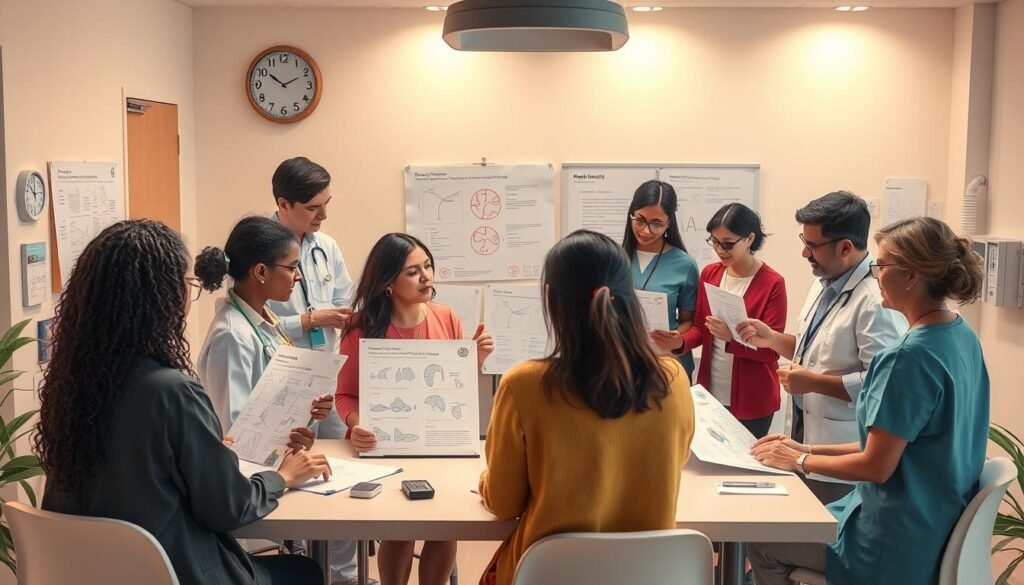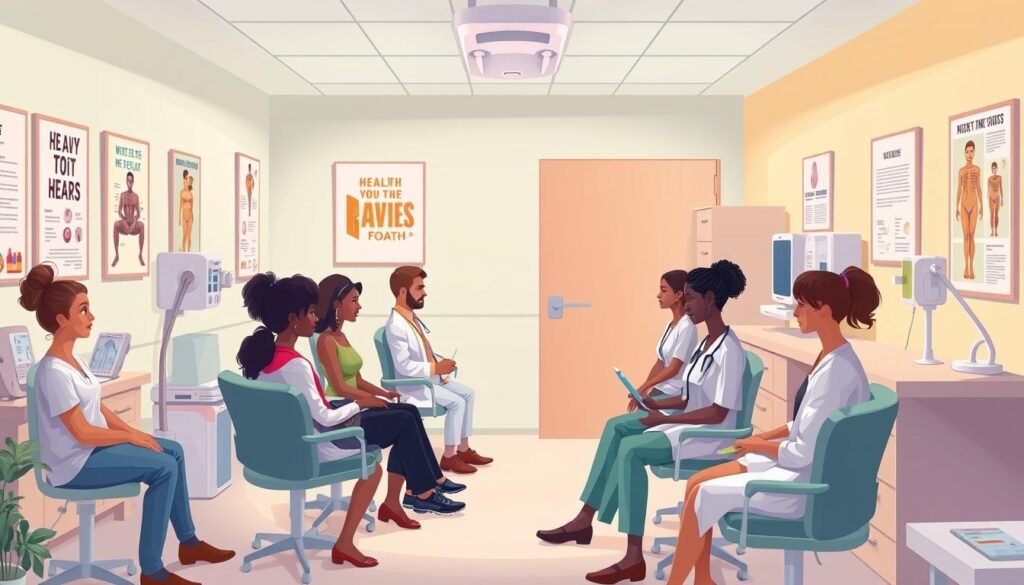Did you know the risk of a woman getting breast cancer rose from 5% in 1940 to 12.6% today? This shows the need for sticking to healthcare screening guidelines. These guidelines help find diseases early, especially cancer, which leads to better health results.
By staying informed, you can lower your risk of serious health problems. Everyone should keep up with screening advice. For example, the American Cancer Society suggests mammograms for women at 40, and colonoscopies at 45 for those at average risk. These steps increase survival rates, with early-detected breast cancer patients having a 90% chance of surviving ten years.
The discussion on cancer screenings is growing. Knowing and acting on screening guidelines is key to keeping healthy. Being proactive lets people make choices for better health outcomes.
Key Takeaways
- Early detection through screenings can lead to significantly improved survival rates.
- Adhering to screening guidelines reduces the risk of cancer and other diseases.
- Different age groups have specific recommendations based on risk factors.
- Regular screenings are essential for effective healthcare management.
- Staying informed empowers individuals to take control of their health.
Understanding Screening Guidelines
Healthcare screening guidelines are key in preventive healthcare. They offer advice on when and how to check for diseases. Their main goal is early detection for better health.
These guidelines are based on solid evidence and update often. This keeps them relevant. They help people and doctors manage health and lower risk.
Following screening guidelines is very important. For example, cervical cancer checks suggest testing every five years for those 30 to 65. This is because studies show it finds more serious issues than other tests.
Risk factors play a big role in screening guidelines. People with certain risks need special checks. This helps catch problems early and stops them from spreading.
For more info on these guidelines, check understanding screening guidelines. It explains their impact on health care.
| Screening Option | Recommended Frequency | Target Age Group |
|---|---|---|
| Primary hrHPV Testing | Every 5 years | 30-65 years |
| Cervical Cytology Alone | Every 3 years | 30-65 years |
| Co-Testing (Cytology and hrHPV) | Every 5 years | 30-65 years |
Knowing these guidelines helps people take active steps to stay healthy and avoid serious diseases.
What Are Healthcare Screening Guidelines?
Healthcare screening guidelines are key rules set by top medical groups, like the American Cancer Society. They help spot illnesses such as cancer early, before symptoms show. These rules tell who needs screening, how it’s done, and how often, to catch diseases early.
These guidelines matter because they weigh the good of finding diseases early against test risks. For example, women over 50 are urged to get mammograms. And colonoscopy screenings start at age 45 or 50, based on your health history. This lets doctors tailor screenings to each person’s risks, like their age and family history.
Some key guidelines are:
- Screening all adults at 45 for diabetes or prediabetes, says the American Diabetes Association.
- Adults 50 to 80 with a heavy smoking past should get yearly low-dose lung scans.
- Men 45 and up need yearly prostate checks.
Following these guidelines helps catch diseases early, leading to better treatment and health. They remind us to see our doctors often, to stay on top of our health and screenings.

For more on these guidelines, check out UCI Health screening guidelines.
Importance of Following Screening Guidelines
Screening guidelines play a big role in cutting down cancer rates. They also make sure people get help early if needed. Getting checked regularly can catch health problems before they become serious.
The Role of Early Detection in Cancer Prevention
Spotting cancer early is crucial for stopping it. Tests can spot changes that may turn into cancer or catch it early. This makes treatment work better. By sticking to guidelines, people get the right tests for their age and risks. This boosts their chances of beating cancer. Research supports the value of being proactive for better health results.
Guidelines for Common Types of Cancer
Each cancer type has its own set of screening suggestions. For colorectal cancer, adults aged 45 to 75 should get checked. Those between 76 to 85 need to decide based on their health. If you’re at high risk, you might need to start younger. Below are the screenings:
| Screening Method | Frequency |
|---|---|
| Annual gFOBT | Every year |
| Annual FIT | Every year |
| FIT-DNA Test | Every 3 years |
| Flexible Sigmoidoscopy | Every 5 years |
| Computed Tomography Colonography | Every 5 years |
| Colonoscopy | Every 10 years |
For breast cancer, the recommendation is biennial mammography for women 40 to 74. This supports the advantages of health care guidance. It helps in finding cancer early and starting treatment. Breast cancer is a big problem, and early detection can make a big difference. Understanding these guidelines is key for everyone’s health.

Benefits of Following Healthcare Guidelines
Following healthcare guidelines has major perks for everyone. It makes healthcare quality better and saves money. By sticking to these guidelines, people get checked and helped in time. This means healthier lives for all.
Improved Health Outcomes
Screening guidelines are like a guide for doctors and patients. They help catch diseases like cancer early. Getting treatment early can save lives, leading to a better life.
Studies show sticking to screening advice means:
- Longer life expectancy
- Lower rates of severe health issues
- Better overall health
Reduction in Healthcare Costs
Focusing on prevention saves people and the system money. Using guidelines wisely means we use resources better. This results in:
| Cost Impact | Before Implementation | After Implementation |
|---|---|---|
| Emergency Care Costs | $2,500 | $1,200 |
| Long-term Treatment Costs | $10,000 | $5,000 |
| Overall Patient Costs | $12,500 | $6,200 |
New guidelines aim to cut unnecessary costs while caring for patient choices. This leads to big health and economic benefits for everyone.
Adherence to Screening Guidelines
Following screening guidelines is key to staying healthy. People might not follow these guidelines due to personal and healthcare system reasons. Knowing why can help us find ways to encourage everyone to get their screenings done on time.
Factors Influencing Adherence
Many things play a part in whether people follow screening advice:
- Socioeconomic Status: People with less money often don’t get screened as much as those with more.
- Education Level: Those who went to school longer are more likely to get checked for cancer.
- Access to Healthcare: Without insurance or a doctor, many skip their screenings.
- Geographical Location: People living in the countryside are better at getting mammograms than city dwellers.
- Awareness of Medical Recommendations: Knowing about the screenings makes a big difference in following them.
Strategies for Patients to Maintain Regular Screenings
To keep up with screenings, patients can try these strategies:
- Use calendars and apps to remember when screenings are due.
- Talk openly with doctors about why screenings are essential.
- Get support from loved ones to stick with screening schedules.
- Join community efforts that help people learn about and get screenings.
Doctors have a big part in making sure patients stick to screening guidelines. They need to talk effectively with patients. This helps patients open up about their worries. Working together, they can improve everyone’s commitment to regular screenings.

Consequences of Ignoring Screening Recommendations
Neglecting the recommended screenings has serious consequences. Skipping these can lead to a late-stage diagnosis, which means worse health outcomes. Being diagnosed with advanced cancer can greatly decrease your chances of survival. It shows how important it is to get screened on time. By ignoring these screenings, people risk facing medical problems that could have been found earlier.
Increased Risk of Late-Stage Diagnosis
Research shows that older adults often skip important screenings. This can result in being diagnosed with cancer later on. The U.S. Preventive Services Task Force stresses the need for colon, breast, and cervical cancer screenings in older people. Not following these advices means a higher chance of finding cancer at a more serious stage. This not only lowers the success rate of treatments but can also lead to the need for more medical care.
Emotional and Financial Burdens
Ignoring screening advice affects more than just physical health. Patients with advanced cancer face big emotional and financial pressures. The worry of a late diagnosis can really hurt one’s mental well-being, and it affects their families too. Plus, treating serious diseases is very expensive, adding a lot of financial stress. So, not going for preventive care can cause a lot of emotional pain and financial difficulty.
Following Medical Screening Recommendations
It’s vital to understand how early detection can improve health. Teaching people to follow medical screening tips can make them more involved in their health care. They can learn through online information, local workshops, and talking directly with health experts. These methods greatly support active health management.
Building Awareness Through Education
Teaching effectively means sharing knowledge that helps people know when to get tested. For instance, women in their twenties and thirties should check their breasts monthly. Men of the same age should examine their skin and testicles. Knowing what to do helps people follow through, which leads to catching issues early and improving health.
Here are some numbers showing why teaching about screenings matters:
| Age Group | Recommendations for Women | Recommendations for Men |
|---|---|---|
| 20s and 30s | Monthly breast self-exams, annual blood pressure checks | Monthly skin cancer and testicular self-exams, annual blood pressure checks |
| 40s | Full-body skin exams and mammograms annually | Full-body skin exams and cholesterol checks every 2-5 years |
| 50s | Bone density tests every 5 years, cardiac calcium scoring every 10 years | Annual cholesterol checks, cardiac calcium scoring every 10 years |
| 60s | Annual dementia and Alzheimer’s screenings | Screen as needed for abdominal aortic aneurysms |
Communicating with Healthcare Providers
Talking openly with health experts is key. Patients should ask questions and share their worries about tests. This talk can ease fears and clear up confusion, helping people stick to health advice. Doctors and nurses need to communicate clearly and give resources that help patients get involved.
Conclusion
Screening guidelines are super important to follow. They help stop diseases early, especially cancer, making treatment easier. Studies show that regular cancer checks decrease death rates. For example, lung cancer deaths dropped by 21% with proper screening.
But, not everyone is getting timely screenings. A concerning fact is that only 53.4% follow up on colorectal cancer tests. Skipping these follow-up checks doubles the chance of dying from this cancer. Knowing your risk and family health history helps manage your health better.
Talking to doctors about screening worries is key to taking care of your health. Everyone should follow the screening advice given. This keeps both you and others around you healthy. For more info on health checks, see Understanding Follow-Ups and Biopsy Requirements.